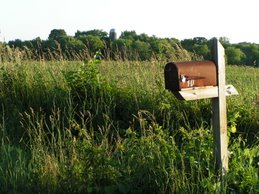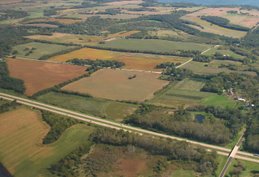Last Tuesday night the room was packed for Dr. Cal DeWitt's remarkable presentation which was entertaining, important, and memorable! If you missed it, you might catch the replay on FACTv.
I'm sorry Channel 15 news was unable to record the unveiling of Dr. DeWitt's latest research during his second presentation to the Plan Commission, which unfortunately was delayed for an hour in order to accommodate people there for other agenda items.
Eau Claire Aquitard and Buried Bedrock Valleys
During his presentation, Dr. DeWitt shared his remarkable and eye-opening discoveries, involving over 700 hours of research since his September 2007 presentation to the Plan Commission. He unearthed to the public, the secrets of the hidden bedrock valleys which lay beneath the surface of Fitchburg. The bedrock was created in layers by various sea deposits over millions of years including a series of deposits from the ancient "Eau Claire Sea."
These deposits of mud, silt, and sand form the Eau Claire Formation and it is the shale in this formation that forms a barrier (aquitard) that separates the upper and lower aquifers. Valleys, cutting through this bedrock, make it look much like the rugged, exposed topography of the driftless area to our west. And the Nine Springs bedrock valley cuts completely through the Eau Claire Formation. After these incisions, however, the valleys around here were filled in by the glacier (which also created a fantastic chain of lakes) and they now lie silently below us.
Through research of previous core samples taken from wells, Dr. DeWitt demonstrated that the aquitard is slowly reduced in thickness from Southwest to Northeast Fitchburg, where it thins as it approaches Lake Waubesa and then disappears completely. This results in a joining of upper and lower aquitards, making them one.
In Northeast Fitchburg, east to west along the 9 Springs E-way, and in much of Madison and Sun Prairie, there is a joining of upper and lower aquifers, and this may more fully explain the reason for Madison's many water quality/contamination problems.
Caution is Urged
Dr. DeWitt strongly urged against drilling any new wells in or near areas where the aquitard is lacking and suggested that Fitchburg steward the land by "sleuthing" the science (hydrology, geology, hydrogeology, limnology) of the area carefully in future planning.
He warned against relying on current groundwater models, when considering new development (such as the Northeast Neighborhood). While these models are helpful for many areas where bedrock is fairly uniform, they do not account for the cutting through of the Eau Claire aquitard by the Nine Springs Bedrock Valley or the thinning of the Eau Claire Shale to zero in the northeast.
Other models being used for runoff similarly must be used wisely; and their current use does not adequately address phosphorus loading inputs. He suggested that unless care is taken to prevent the eutrophication of Lake Waubesa, by reducing the phosphorus runoff below levels found in present and future developed neighborhoods, Fitchburg would eventually pay in increased taxes for future remediation to restore the watershed.
Rosanne Lindsay
Fitchburg
- - - - - - - - - - - - - -

Terry Carpenter
Fitchburg


